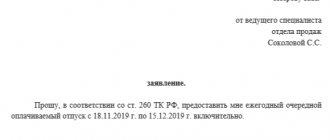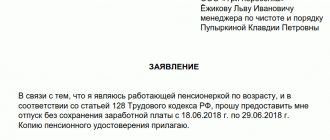Vacation: concept, types, duration.
Vacation is a continuous rest period for a certain number of calendar or working days in a working year, which is provided to employees while maintaining the average salary in their position.
The legislation establishes the following types of leave:
• basic and additional;
• normal duration - basic (28 calendar days), extended (for example, according to Article 267 of the Labor Code of the Russian Federation for minor workers - duration 31 calendar days);
• paid and without salary.
The criteria for dividing leave into types are their grounds and purposes: leave for employees engaged in work with harmful and dangerous working conditions; for the special nature of the work; for length of service; workers with irregular working hours; maternity leave; study holidays.
By providing annual paid leave, the right of employees to rest is ensured. While on vacation, an employee cannot be dismissed at the initiative of the employer, with the exception of the case of liquidation of the organization or termination of activities by the employer - an individual (Article 81 of the Labor Code of the Russian Federation). According to Art. 121 of the Labor Code of the Russian Federation, the time of annual paid leave is included in the employee’s total and continuous work experience, as well as in the length of service giving the right to annual basic paid leave.
Annual paid leave is provided in each working year, which is calculated from the date of conclusion of the employment contract with a specific employer and usually does not coincide with the calendar year.
Article 121 of the Labor Code of the Russian Federation contains an exhaustive list of periods that are included in the length of service that gives the right to annual paid leave. Such periods include, for example, the time of actual work, i.e. the time during which the employee actually performed a labor function in accordance with the employment contract (Article 93 of the Labor Code of the Russian Federation); the time when the employee did not actually work, but in accordance with federal laws he retained his place of work (position); the time of suspension of work by bodies of state supervision and control over compliance with labor protection requirements due to violation of labor protection requirements through no fault of the employee (Article 220 of the Labor Code of the Russian Federation), as well as other periods.
Article 122 of the Labor Code of the Russian Federation establishes that the right to use vacation for the first year of work arises for an employee after six months of continuous work in this organization. Before the expiration of six months, leave must be granted at the request of the employee in the following cases:
1) for women - before maternity leave or immediately after it;
2) employees under the age of 18;
3) employees who adopted a child (children) under the age of three months;
4) in other cases provided for by law.
In some cases, annual paid leave should be provided to employees at a time convenient for them. This requirement also applies to the first year of work, when leave must be provided in advance (before the expiration of six months of continuous work),
Vacation for the second and subsequent years of work can be granted at any time of the working year in accordance with the priority established in the given organization (vacation schedule). At the same time, the possibility of granting two vacations for different working years in one calendar year is not excluded. The approved schedule must be communicated to all employees. In Art. 124 of the Labor Code of the Russian Federation establishes a rule according to which the employer is obliged not only to acquaint the employee with a receipt with the schedule, but also to notify him of the start time of the vacation no later than two weeks before it begins. Otherwise, the vacation is postponed to another date.
If for any reason an employee cannot use vacation on the days specified in the schedule, he has the right to contact the employer with a request to postpone it. When a vacation is postponed to another time, appropriate changes are made to the vacation schedule.
In accordance with Art. 115 of the Labor Code of the Russian Federation, employees are granted annual basic paid leave of 28 calendar days. For some categories of employees, the law establishes extended basic leave (more than 28 calendar days). Non-working holidays falling during the vacation period are not included in the number of calendar days of vacation and are not paid.
When calculating the total duration of annual paid leave, additional paid leaves are summed up with the annual main paid leave (Article 120 of the Labor Code of the Russian Federation). As a general rule, leave is granted in its entirety, but by agreement of the parties to the employment contract, annual paid leave can be divided into parts. The legislation does not establish how many parts the vacation can be divided into. According to Art. 125 of the Labor Code of the Russian Federation, the indivisible part (at least one of the parts, not necessarily the first) must be at least 14 calendar days.
Recall of an employee from vacation is possible only with his consent. An employee’s refusal to go to work when called back early from vacation is not a violation of labor discipline and cannot lead to disciplinary sanctions. According to Art. 125 of the Labor Code of the Russian Federation, workers under the age of 18, pregnant women and workers engaged in work with harmful and (or) dangerous working conditions are not allowed to be recalled from vacation.
In case of illness of an employee while on regular leave, the latter is subject to extension by the number of days of temporary disability.
According to Art. 177 of the Labor Code of the Russian Federation, annual paid leaves by agreement of the employer and employee can be added to additional study leaves. In this case, the annual paid leave is extended or postponed.
Article 124 of the Labor Code of the Russian Federation prohibits the failure to provide annual paid leave for two years in a row, as well as the failure to provide leave to employees under the age of 18 and employees engaged in work with harmful and (or) dangerous working conditions.
How many weeks are counted during one calendar year and how many are there?
Another important concept established in federal law is the calendar week. The calendar weeks of 2021, like any other, are seven-day periods that last strictly from Monday to Sunday.
The concept of a calendar week is used to calculate the duration of work and calculate the wages of seasonal workers. It is also relevant for resolving issues of dismissal. For example, it is convenient to calculate the notice period for an upcoming dismissal, focusing specifically on the concept of a calendar week.
You will find samples of filling out pay slips and payroll slips, which indicate the days worked, in the standard ConsultantPlus solution. You will receive even more relevant solutions if you sign up for a free trial access to K+.
Subscribe to our newsletter
Yandex.Zen VKontakte Telegram
Find out if it is possible to be fired on a day off.
The number of calendar weeks in a year is 52 or 53 (in 2021 - 53).
The procedure and rules for calculating vacation experience using examples - what to take into account and what to exclude?
The vacations of these persons cannot be transferred to the next working year, even at the request of the employees themselves.
In some cases, the employer may (but is not obligated to) provide the employee, at his request, with unpaid leave. Part 2 Art. 128 of the Labor Code of the Russian Federation lists cases when an employer is obliged, based on a written application from an employee, to provide leave without pay:
1) participants of the Great Patriotic War - up to 35 calendar days a year;
2) working old-age pensioners (by age) - up to 14 calendar days per year;
3) parents and wives (husbands) of military personnel who died or died as a result of injury, concussion or injury,
received during the performance of military service duties or as a result of an illness associated with military service - up to 14 calendar days per year;
4) for working disabled people - up to 60 calendar days per year;
5) employees in cases of the birth of a child, marriage registration, death of close relatives - up to five calendar days;
6) in other cases provided for by the Labor Code of the Russian Federation, other federal laws or a collective agreement.
In accordance with Art. 263 of the Labor Code of the Russian Federation to an employee who has two or more children under the age of 14 years (a disabled child under the age of 18 years), a single mother raising a child under the age of 14 years, a father raising a child under the age of 14 years without a mother, collective The contract may establish annual additional leaves without pay at a time convenient for them, lasting up to 14 calendar days.
Providing an employee with leave without pay is formalized by order (instruction) of the employer. During unpaid leave, the employee retains his place of work (position). According to the provisions of Art. 121 of the Labor Code of the Russian Federation, time of unpaid leave lasting more than 14 calendar days is not included in the length of service giving the right to annual basic paid leave.
Didn't find what you were looking for? Use Google search on the site:
How to count the calendar days of the billing period to be taken into account
When the billing period is fully worked out, the number of calendar days taken into account is determined as the product of the average monthly number of calendar days (29.4) and the number of full calendar months. It will be equal to 352.8 calendar days (29.4 x 12 months).
If one or more months of the billing period are not fully worked out or time is excluded from it in accordance with clause 5 of the Regulations on Average Earnings, the number of calendar days taken into account is determined as the sum of the product of the average monthly number of calendar days (29.4) by the number of full calendar months and the number of calendar days in incomplete calendar months.
The number of calendar days in an incomplete calendar month is determined by dividing the average monthly number of calendar days (29.4) by the number of calendar days of this month and multiplying by the number of calendar days falling on the time worked in this month.
This procedure is established in clause 10 of the Regulations on Average Earnings.
We will show how to determine the number of calendar days of the billing period to be taken into account using an example.
Example 4 . E.G. Antilskaya was hired at Guadalupe CJSC on March 22, 2010. From January 15, 2011, she was on maternity leave, and from June 4, 2011, on maternity leave for up to one and a half years.
On October 2, 2012, she returned to work and immediately took 14 days of annual paid leave.
From March 11 to March 24, 2013 E.G. Antilles was on a business trip. From May 20 to May 31, 2013, I took sick leave.
Let us determine the calculation period for E.G.’s annual paid leave. Antilles, to which she has been leaving since September 16, 2013.
Solution. The calculation period for the employee's leave will be 12 calendar months preceding September 2013 - from September 1, 2012 to August 31, 2013. In the calculation period, the employee was:
- from September 1 to October 1, 2012 (30 days in September and 1 day in October) - on parental leave for a child up to one and a half years old;
- from October 2 to October 15, 2012 (14 calendar days) - on annual paid leave;
- from March 11 to March 24, 2013 (14 calendar days) - on a business trip;
- from May 20 to May 31, 2013 (12 calendar days) - on sick leave.
All these periods must be excluded from the billing period.
Total in the billing period E.G. Antilles worked fully for 8 months, did not work in September, and did not work fully for 3 months of the billing period (October 2012, March and May 2013).
Let's calculate the number of calendar days in months that are not fully worked:
- in October 2012 it will be 15.2 days [29.4 x (31 days - 1 day - 14 days) : 31 days];
- in March 2013 - 16.1 days [29.4 x (31 days - 14 days) : 31 days];
- in May 2013 - 18 days [29.4 x (31 days - 12 days) : 31 days].
The number of calendar days in fully worked months will be 235.2 days (29.4 x 8 months).
The total number of calendar days taken into account is 284.5 days (15.2 days + 16.1 days + 18 days + 235.2 days).
How to determine the working year for the next annual leave and its duration
In this case, non-working holidays falling during the vacation period are not included in the number of calendar days of vacation and are not paid. This means that if the vacation falls on such days, then it is, as it were, extended.
If an employee is granted additional paid leave, then when calculating the total duration of annual paid leave, they are summed up with the main one.
Sometimes an employee, due to valid reasons (for example, illness), cannot fully use his vacation. For such cases, the law provides for an extension of vacation, i.e., postponing the date of return to work by the number of days on which the employee, if he were not on vacation, would still be relieved from performing work duties for other valid reasons.
Annual paid leave must be extended in the following cases:
• temporary disability of the employee;
• the employee performs state duties during his annual paid leave, if the law provides for this by exemption from work;
• in other cases provided for by laws and local regulations of the organization.
Procedure for granting annual paid leave
Paid leave must be provided to the employee annually. The right to use vacation for the first year of work
arises for an employee after six months of continuous work with a given employer.
At the same time, the length of service that gives the right to annual basic
paid leave includes:
• time of actual work;
• the time when the employee did not actually work, but in accordance with federal laws he retained his place of work (position);
• time of forced absence due to illegal dismissal or suspension from work and subsequent reinstatement to the previous job;
• other periods of time provided for by the employment contract, collective agreement, other local regulatory act of the organization.
At the same time, this experience does not include:
• the time the employee is absent from work without good reason, as well as his legal removal from work
• time of maternity leave;
• vacation time without pay lasting more than seven calendar days.
When deciding on an employee’s right to paid leave, only the time worked for a given employer is taken into account. However, in cases where an employee was employed by an organization by way of transfer and did not use leave at his previous place of work, he: has the right to demand the first leave from the new employer, based on the total six-month length of service at the previous and new place of work.
By agreement of the parties to the employment contract, the first paid leave may be granted to the employee before the expiration of six months of his continuous work. However, for some employees the employer is obliged
upon their application, provide such leave before the specified period, namely:
• for women - before maternity leave or immediately after it;
• employees under 18 years of age;
• employees who have adopted a child (children) under the age of three months;
• in other cases provided for by federal laws. Vacation for the second and subsequent years of work is granted at any time of the working year in accordance with the priority established in the organization. This priority is determined annually in accordance with the vacation schedule,
approved by the employer, taking into account the opinion of the elected trade union body no later than two weeks before the start of the calendar year.
The vacation schedule is mandatory for both the employer and the employee. This means that if, for example, an employee independently, without taking into account the date of granting him leave according to the schedule, “went” on vacation, then this is equivalent to absenteeism. Likewise, if the employer does not comply with the priority schedule for granting vacations, then this is considered a violation of the rights of employees with corresponding consequences. The employee must be notified of the start time of the vacation no later than two weeks before it begins.
Certain categories of employees, in cases provided for by federal laws, are granted annual paid leave at their request at a time convenient for them. For example, at the request of the husband, he is granted annual leave while his wife is on maternity leave, regardless of the time of his continuous work in this organization.
Postponement of vacation
for another period is possible by agreement between the employee and the employer, if the employee was not paid on time during this vacation or the employee was notified about the start time of the vacation later than two weeks before it began.
Transferring vacation to the next working year
permitted with the consent of the employee in exceptional cases when the provision of leave in the current working year may adversely affect the normal course of work of the organization. In this case, the leave must be used no later than 12 months after the end of the working year for which it is granted.
In any case, it is prohibited to fail to provide annual paid leave for two years in a row, as well as to employees under the age of 18 and to employees engaged in work with harmful and (or) dangerous working conditions.
The legislation allows for the division of vacation into parts, in which a certain number of vacation days are used during the period provided for the next vacation, and the remaining number is transferred to another time. Division of leave is possible only by agreement of the parties, so if, for example, an employee does not respond to the employer’s initiative, then no one has the right to oblige him to give his consent. When dividing vacation, at least one of its parts must in any case be at least 14 calendar days.
Recall from vacation is permitted only with the consent of the employee. The part of the vacation not used in connection with the recall must be provided at the employee’s choice at a time convenient for him during the current working year or added to the vacation for the next working year.
Under no circumstances (even with the consent of the employee) is it permitted to recall from vacation workers under the age of 18, pregnant women and workers engaged in work with harmful and (or) dangerous working conditions.
Replacement of vacation with monetary compensation is possible only at the initiative of the employee if the duration of the vacation exceeds 28 calendar days. In this case, upon the employee’s written application, monetary compensation replaces that part of the vacation that exceeds the specified period. It is not allowed to replace vacation with monetary compensation for pregnant women, employees under the age of 18, and employees engaged in heavy work and work with harmful and (or) dangerous working conditions (i.e., the same categories of employees for whom recall from vacation is prohibited ).
In case of dismissal, the employee is paid monetary compensation for all unused vacations upon final settlement with him. However, upon a written request from the employee, unused vacations may be granted to him with subsequent dismissal (except for cases of dismissal for guilty actions). In this case, the day of dismissal is considered the last day of vacation.
Date added: 2015-01-15; ;
as of January 25, 2005
<<< Home page | < Back
According to Art. 163
Labor Code of the Republic of Belarus
the working year
for which labor leave is granted is a period of time equal in length to a calendar year, but calculated for each employee from the date of hiring.
Each working year is calculated not from the end date of the next vacation, but from the date of hiring. So, if an employee was hired on March 20, 2001, then the working year for his vacation will be determined from March 20, 2001 to March 20, 2002, etc.
Thus, the concept of “working year” for calculating vacation differs significantly from the concept of “calendar year,” which implies a period of time, for example, from January 1, 2001 to January 1, 2002, although the working year is equal in length to the calendar year.
The legislation provides for cases when, when calculating labor leave, the working year may shift by certain periods of time. We are talking about those periods of time that are not included in the actual time worked (see Art.
What is a calendar year in a contract and how is it calculated?
When concluding contracts, the parties must have a clear understanding of what a calendar year is. However, this concept is often used in contracts without proper understanding.
For example, the parties entered into an employment agreement for the period from April 2021 to April 2021 with the condition that if there is no expression of the will of the parties, the agreement will be extended for one calendar year. Taking into account the provisions of Law No. 107-FZ, it is not worth asserting that the contract in this case will last until April 2021, since the calendar year is counted from January 1 to December 31. This means that the contract will only be extended until December 31, 2021, and clearly shows why it is so important to know how to calculate the calendar year.
Working year: what periods to take into account
165 TK).
An employee may be granted only one leave of absence per working year. Vacations for the second and subsequent years of work by the employer are granted at any time of the working year in accordance with the priority of vacations, including in advance. Labor leave in accordance with Part 1 of Art. 166
of the Labor Code of the Republic of Belarus for the first year of work is provided to employees after at least 6 months of continuous work with a given employer. The exception is cases provided for in parts 2, 3, 4 of Art. 166 of the Labor Code of the Republic of Belarus, under which employees are granted labor leave until the end of 6 months of work. It is not permitted to grant labor leave in advance before the start of a working year that has not yet begun.
<<< Home page | < Back
Partner news
pravo.kulichki.ru ::: pravo.kulichki.com ::: pravo.kulichki.net
2004-2015 Republic of Belarus
For what period of work is annual leave granted?
In accordance with Art. 37 of the Constitution, all workers have the right to rest, the implementation of which is carried out in various forms. In particular, as stated in Art. 21 Labor Code, employees go on vacation every year. It refers to the time of release from work duties for the purpose of rest, paid by the employer.
Basic leave is granted for the period of work during which the employee worked under an employment contract with one employer. According to Art. 122 Labor Code distinguishes several periods:
- After 6 months from the beginning of the 1st year of work with the employer.
There are exceptions. The employer has the right to provide leave earlier at the request of the employee and is obliged to do this when the following person declares about early leave:
- minor worker;
- an employee who adopted a newborn (up to 3 months);
- a woman before or after maternity leave (hereinafter referred to as Maternity leave);
- a part-time employee receiving leave from his main job;
- teacher of a disabled minor child;
- a man while his wife is on leave under the BiR;
- another worker who has received such a right on the basis of the law.
Every year from the 2nd year of work.
NOTE! When calculating the period in which vacation is provided, not the calendar year, but the working year is taken into account. Therefore, an employee can legally go on vacation for 28 (or more) days twice in a calendar year.
The procedure for calculating vacation time - examples
05 05 2021 otpusknik No comments yet
Vacation period is the period of time for which an employee has the right to demand annual paid leave. There are some features in its calculation that must be taken into account to determine the vacation days due to the employee. The article discusses how to calculate vacation time step by step, provides specific steps in the calculation, and also gives an example of the calculation in numbers.
Providing vacations to its employees is the responsibility of the employer and is enshrined in Article 121 of the Labor Code of the Russian Federation. A citizen has the right, after six months of work at a new enterprise, to write a statement to the manager and ask for another vacation. For one full year of work, he will receive 28 calendar days of vacation. The management of the enterprise must also provide some employees with additional leave.
What are the differences between working year, vacation period and pay period?
“Salary”, 2013, N 10
When calculating vacation pay and compensation for unused vacation, accountants use concepts such as working year, vacation experience and payroll period. What characterizes each of them, how they differ and how they are used when calculating vacation pay, we will consider in the article.
The working year, vacation period and pay period are certain periods of time, for each of which the starting point is important. At the same time, time worked with previous employers is not included in any of the periods.
Working year. The first working year is counted from the date of employment of the employee in the company:
- from the date of commencement of his work specified in the employment contract (paragraph 4, part 2, article 57 of the Labor Code of the Russian Federation);
- from the date of actual admission to work, if the employment contract with him was not properly drawn up (Part 3 of Article 16 of the Labor Code of the Russian Federation).
Subsequent working years begin on the day following the end of the previous working year.
Vacation experience. The counting of the vacation period, as well as the employee’s first working year, begins from the day of his employment with the employer. Vacation experience is the total length of service of an employee in a given company, which consists of the employee’s working years.
The calculation period for calculating vacation pay is 12 calendar months and is counted from the month preceding the month in which the employee goes on vacation.
Thus, the working year and vacation experience have the same starting point, but, as a rule, different durations. The calculation period has a completely different starting point.
How to calculate vacation time correctly
At the same time, the task of the HR department specialists is to correctly calculate the beginning and end of the year for which rest days will be provided. These dates are indicated in the vacation order. It is especially important to accurately determine the vacation period if an employee quits his job and the company is obliged to calculate and pay compensation for vacation not taken on the date of dismissal. How to calculate compensation for vacation upon dismissal.
To correctly calculate the length of service for vacation, you need to know the following:
- what is a working year?
- what periods should be included in the length of service;
- which periods do not need to be included in the length of service.
What is a working year for vacation
The working year is calculated separately for each employee.
The role of experience
The legal meaning of length of service is very broad, so it is worth highlighting the role of each of its types listed above separately.
General labor
The significance of this type of experience is that it is used when assigning the following types of pensions to a citizen:
- by old age;
- in case of loss of a breadwinner;
- on disability.
In some cases, its presence is also necessary to apply for a long service or old age pension, but on a preferential basis.
Special labor
Its role is as follows:
- taking it into account, an old-age pension is established for workers whose activities were carried out in the Far North or had special working conditions;
- the size of the percentage increase to the employee’s salary, as well as the annual remuneration for long service, depends on its duration;
- taking it into account, the long-service pension is determined, if such a right exists for representatives of certain professions.
An example of such professions and activities are work underground, in harmful or dangerous working conditions, in logging, in hot shops, etc.
Continuous
Its meaning is as follows:
- the amount of unemployment benefits that is assigned to a citizen upon registration depends on its duration;
- it is associated with the payment to the employee of bonuses and additional payments to the salary (or tariff rate);
- its duration affects the amount of remuneration based on the results of work for the year.
As for the pension sector, this type of length of service currently has no meaning.
Insurance
In modern conditions, its presence in a minimum amount (5 years) is a prerequisite for granting an old-age pension. In the absence of such length of service, a pension cannot be granted.
Taking it into account, the pensioner’s individual coefficient is also determined, the value of which, in turn, directly affects the size of pension payments.
Vacations: concept, types, duration, procedure for granting annual leave
When you leave your old job, your vacation period is interrupted. The previous employer pays compensation for unused vacations. The new employer begins to count the year of work anew from the date of hire. The duration of the first year is 12 months. The second year begins the day after the end of the first and continues for another 12 months. This may be the case in the standard case.
In practice, the working year does not always coincide with the calendar year. A person can work at night and on holidays, stay late to do overtime, or be a part-time worker. It is possible that he will be absent from work for both good and bad reasons. All information about the time of presence and absence is reflected in the working time sheet and the employee’s personal card. When calculating vacation experience, data on time worked is analyzed. And if there are periods of absence that are excluded from the leave period, the end date of the working year will change.
Excluded periods from vacation experience
Some periods of time when the employee was not engaged in performing his job duties should not be included in the length of service for calculating vacation days. These include:
- Days of absenteeism, suspensions from work and other absences without good reason.
- Parental leave for up to three years.
- Vacation at your own expense for more than 14 calendar days a year.
These periods are considered unrelated to work, and the working year will end later by the number of days of such absence.
What periods are included in the length of service?
When calculating the working year for annual paid leave, you should include all the time that the employee performed duties at the workplace in accordance with the employment contract, as well as while on a business trip.
Cases of employment on weekends and holidays must be issued by a separate order. These periods are added to the length of service, just like overtime hours.
Shortened working hours established by law are not removed from the calculation:
- for students, during on-the-job training;
- for disabled people, minors, workers employed in hazardous industries.
Days will also be included in the vacation period if the employee did not go to work due to valid reasons.
These include:
- The time when the employee was actually absent, but according to the law, his job was retained. Reasons for absence are:
- vacation;
- disease;
- holidays and weekends;
- paid additional days off;
- additional days of vacation without pay;
- training;
- performance of government duties;
- simple production.
- Unlawful removal from work or dismissal.
Step-by-step calculation of vacation time
To calculate the length of service for annual paid leave, you need to determine the start and end date of the working year. To do this you need:
| Step 1 | Specify the date of commencement of work. |
| Step 2 | Analyze the employee’s absence and presence at work for a year from the date of hiring. |
| Step 3 | If there are periods to be excluded, calculate the number of such days. |
| Step 4 | Adjust the end date of the working year for the days excluded from the calculation. |
Calculation example
Let's look at an example of calculating length of service for vacation in a specific case.
- November 1, 2014 mechanic Kolosov A.P. was hired.
- From March 14, 2015 to March 23, 2015, he was absent due to illness.
- In 2015, the regular vacation lasted from December 4 to December 31, in 2021 - from November 3 to November 30.
- On August 12 and 13, 2015, he was suspended from work due to late medical examination due to the employee’s fault.
- From May 15 to June 2, 2021, I was on leave without pay.
- Effective April 30, 2021, the employee will resign. It is necessary to determine the length of service to calculate compensation for unused vacation.
Of all cases of absence from work, the vacation record does not include days of suspension from duties and leave “at one’s own expense” for more than two weeks.
Definition of working years:
- The first year of work of Kolosov A.P. starts from the date of hiring on November 1, 2014 and ends on November 2, 2015. The end of the year was pushed back by two days due to the suspension period.
- The second working year begins on November 3, 2015 and ends on November 7, 2021. The shift in the end date of the working year was due to leave without pay exceeding the two-week period by 5 days.
- The third year of operation began on November 8, 2021. Leave for the period from this day until dismissal was not provided and will be compensated by cash payment.
It is necessary to determine the number of complete months worked for the third year. It turns out 5 months and 22 days. A period of more than half a month is rounded to the nearest whole month. Therefore, compensation must be paid on the basis that the vacation was not used for 6 months.
What is not included in work experience
The length of service that entitles an employee to leave with a given employer does not include:
- the time the employee is absent from work without a valid reason;
- time of parental leave until the child reaches the legal age;
- calendar days of vacation at your own expense, granted during the working year, starting from the 15th day. In this case, the employee’s working year is extended by the number of days of such leave exceeding 14.
Periods excluded from the length of service giving the right to leave extend the employee’s working year.
Let's continue the previous example.
Example 2. How the working year is extended From August 1 to August 25, for family reasons, Mikhailov was granted leave at his own expense for 25 calendar days. Such leave is included in the length of service required to calculate the next leave, but in an amount of no more than 14 calendar days. The employee's working year is extended by the number of calendar days of unpaid leave exceeding 14 days. In this case, this amount is equal to 11 days (25 days - 14 days). Thus, Mikhailov’s first working year in the company will end on March 11 next year, and the next one on March 12 next year. From this date, Mikhailov receives the right to the next annual paid leave in the next accounting year.
Rostrud periodically clarifies such issues (see letters dated June 14, 2012 No. 854-6-1, dated November 23, 2021 No. 14-2/B-933). The last time it was a letter from the Moscow Labor Inspectorate dated June 4, 2020 No. 77/10-20669-OB/18-1299.











